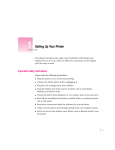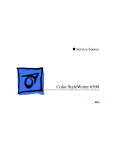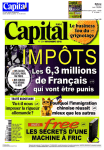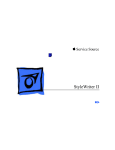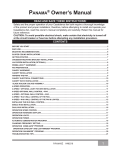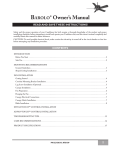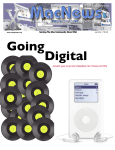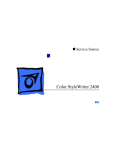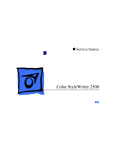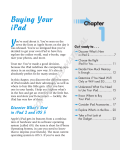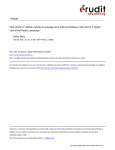Download Apple Color StyleWriter 4500 Specifications
Transcript
K Service Source Color StyleWriter 4100 and 4500 K Service Source Basics Color StyleWriter 4000 Series Basics Overview - 1 Overview The Color StyleWriter 4000 Series printers are desktop color bubble-jet printers for personal use. Basics Overview - 2 Color StyleWriter 4500 and 4100 Differences The Color StyleWriter 4500 and the Color StyleWriter 4100 differ in the following ways: • Color StyleWriter 4500 can produce photo-quality prints. • Color StyleWriter 4500 can print on banner (zfold) paper. • Color StyleWriter 4500 prints slightly faster than the Color StyleWriter 4100. Basics Overview - 3 Ink Cartridge Configurations The Color StyleWriter 4500 and 4100 can be configured with • Color ink cartridge • High-performance black ink cartridge The Color StyleWriter 4500 can also be configured with • Color ink cartridge • PhotoGrade ink cartridge. In the Color StyleWriter 4500, replace the black cartridge with the PhotoGrade ink cartridge for photo-quality printing. Basics Overview - 4 Troubleshooting LEDs Resume Power The Color StyleWriter 4500 and 4100 have two LEDs, Power and Resume, that can aid in troubleshooting the printer. See the Troubleshooting chapter for more information. Basics Overview - 5 Ink-jet Technology Overview Thermal ink-jet technology involves applying heat to a tiny measure of ink until it expands and forms a bubble. As the bubble continues to expand and burst, it is propelled through one of the nozzles on the ink cartridge. This process is repeated up to 8,000 times per second. Each ink cartridge on the Color StyleWriter 4500 and 4100 has 48 nozzles. On the black ink cartridge, all 48 nozzles are used for black ink. On the color and PhotoGrade cartridges each color (cyan, magenta, and yellow) has 16 nozzles each. Basics Overview - 6 Photo Printing Technology The Color StyleWriter 4500 uses multiple dye-load technology to produce photorealistic print-outs. Two ink cartridges are used to produce these results: the color and the photo ink cartridges. The color cartridge contains cyan, magenta, and yellow inks. The PhotoGrade cartridge contains cyan, magenta, and yellow inks mixed with a black pigment. The three additional colors in the PhotoGrade cartridge quadruples the number of ink color ratios that can be printed in a given area. The resulting colors produced from the PhotoGrade cartridge are more subtle shades and hues. The PhotoGrade cartridge also produces smaller ink droplets, which can be layered on top of each other to vary the intensity. Basics Ink Cartridge Identification - 7 Ink Cartridge Identification Caution: Do not get the printer’s ink on your hands or clothes. Although the ink is water soluble, it contains dyes that will stain. Color Cartridge Black Cartridge Note: The Color StyleWriter 4500 includes three ink cartridges: black, color, and PhotoGrade. The Color StyleWriter 4100 includes only the black and color cartridges. Basics Ink Cartridge Identification - 8 High-Performance, Black-Only Ink Cartridge The black ink cartridge contains black ink only. Color Ink Cartridge The color ink cartridge contains cyan, magenta, and yellow inks. Color PhotoGrade Ink Cartridge The PhotoGrade ink cartridge contains cyan, magenta, yellow inks and black pigment. Important: The Color StyleWriter 4500 includes the ink cartridge and PhotoGrade paper. For photorealistic results, the kit contents must be used together. These parts cannot be used in the Color StyleWriter 4100. Basics Ink Cartridge Identification - 9 Identifying Replacement Ink Cartridges 6105 The ink cartridges used with the Color StyleWriter 4100 and 4500 have a generic cartridge labels. There is no Apple logo or Apple part number on the cartridge. To identify a cartridge, refer to the small numeric part number on the label. This number can be cross-referenced to the appropriate Apple Marketing number in the chart that follows. Basics Ink Cartridge Identification - 10 Identify ink cartridges by cross referencing the chart below. Apple Marketing Part Number M5694G/A M5693G/A M5692G/A Product Description HP Cartridge Color Ink Cartridge (CSW 4100 & 4500) 6107 Color PhotoGrade Ink Cartidge (4500 only) 6104 Black Ink Cartridge (CSW 4100 & 4500) 6106 Note: Apple ink cartridges can be found at most Apple authorized dealers, as well as most office product and computer superstores. Catalog and mail order houses which specialize in Macintosh products, such as MacWarehouse, MacMall, and MacZone carry a complete selection of genuine Apple Printer Supplies. You can also call the Apple Reseller Referral number at 1-800-538-9696, which will refer you to an authorized Apple dealer in your area. Basics Recommended Paper - 11 Recommended Paper Apple recommends Apple Color Ink-Jet PREMIUM PLUS Coated Paper. It is the coated paper of choice to use with the Color StyleWriter 4100 and 4500 ink-jet printer. • Letter size p/n M4792G/ A • A4-size p/n M4791G/A. Basics Printing a Photograph - 12 Printing a Photograph The Color StyleWriter 4500 has the capability to produce photo-quality printouts. Follow these procedures 1 2 Remove the black print cartridge and replace it with the PhotoGrade Ink cartridge. Load the PhotoGrade paper into the sheet feeder so the whiter side faces you. Basics Printing a Photograph - 13 3 4 5 6 Choose Page Setup from the File menu. In the Page Setup dialog box, select PhotoGrade from the Paper Type pop-up menu. Select the “Use Color PhotoGrade Ink Cartridge” option. Click Print. Basics Printing a Banner - 14 Printing a Banner Follow these steps to print on banner (z-fold) paper using the Color StyleWriter 4500. 1 2 Choose Page Setup from the File menu. In the Page Setup dialog box, choose either Banner US Letter or Banner A4 from the Paper Size pop-up menu. Basics Printing a Banner - 15 3 4 5 Banner Support 6 Banner Lever Slide the banner lever to the right until it clicks into place. Remove all paper from the input tray. Flip up the banner support in the output tray. Put the paper in the input tray, with a torn edge at the top of the stack, facing lengthwise into the printer. Basics Printing a Banner - 16 7 8 Slide the paper width and length adjusters so they touch the edges of the stack of paper. Click Print. Note: When printing stops, press the Resume button as many times as necessary to advance the remaining banner paper out of the printer. Basics Special Servicing Considerations - 17 Special Servicing Considerations Banner Calibration After replacing the logic board or ink cartridges you must re-calibrate the Color StyleWriter 4500 banner printing. Performing this calibration requires using the Color StyleWriter 4500 Banner Calibration utility found in the Diagnostic folder on the Companion CD. Refer to Additional Procedures for more information. Capping Assembly Replacement If a Color StyleWriter 4100 or 4500 printer is brought in for service, and the customer has had the printer for awhile, replace the capping unit. Capping Assembly 4100: 922-3010 Capping Assembly 4500: 922-2855 Basics - 18 Mechanical Assembly Screws Important: Do not touch/remove mechancial assembly screws (for any reason) that are not called out in the Take Apart chapter for the Color StyleWriter 4000 Series. Doing so will put the printer out of alignment and will require installing a new mechanical assembly. K Service Source Specifications Color StyleWriter 4000 Series Specifications Characteristics - 1 Characteristics Print Methods Throughput Serial bubble jet ink-on-demand Best: Up to one page per minute with the black ink cartridge Up to .3 page per minute for color Normal: Up to three pages per minute with the black ink cartridge Up to .8 page per minute for color Draft: Up to five pages per minute with the black ink cartridge Up to 1.7 pages per minute for color Actual speed depends on the documents printed and the Macintosh used. Specifications Characteristics - 2 Note: The Color StyleWriter 4100 prints at slightly slower rates: up to four pages per minute with the black ink cartridge, and up to 1.4 pages per minute for color. Interfaces • High-speed serial RS-422 port supports serial connection • Printer can be hooked up to LocalTalk, but not as a shared printer. Specifications Graphics - 3 Graphics Resolution Black: Best: 600 x 600 dpi Normal: 600 x 300 dpi Draft: 300 x 300 dpi Color & Black: All Modes (plain paper): 300 x 300 dpi All Modes (other media paper): 600 x 300 dpi Color & Photo: Best & Normal (photograde paper): 600 x 300 dpi Note: The Color StyleWriter 4100 cannot print using the photo ink cartridge. Specifications Print Media - 4 Print Media Cut Sheets Labels Plain paper, coated (recommended for color picture output) Color PhotoGrade paper (required for photorealistic color output) LTR, LGL, Executive, A4, A5, B5 U.S. Letter (LTR): 8.5 x 11 in. (215.9 mm x 279.4 mm) U.S. Legal (LGL): 8.5 x 14 in. (215.9 mm x 355.6 mm) U.S. Executive: 7.25 x 10.5 in. (184.1 x 266.7 mm) A4: 8.3 x 11.7 in. (210 mm x 297 mm) A5: 5.8 x 8.3 in. (148.5 x 210 mm) B5: 7.2 x 10.1 in. (182 x 257 mm) Weight: 16-36 lb. Capacity: 100 sheets Avery paper labels designed for inkjet printers Letter, A4 Capacity: 25 sheets. Specifications Banner Print Media - 5 U.S. Letter Banner: 8.5 x 11 in. (216 x 279 mm) U.S. A4 Banner: 8.5 x 14 in. (216 x 356 mm) Weight: 20 lbs. Capacity: 20 sheets Note: The Color StyleWriter 4100 cannot print on banner paper. Cards Transparencies U.S. 4 x 6: 4 x 6 in. (101.6 x 152.4 mm) U.S. 5 x 8: 5 x 8 in. (127 x 203.3 mm) A6: 4.1 x 6 in. (105 x 148.5 mm) Height: 3.9 x 5.8 in. (100 x 148 mm) Weight: 29-53 lbs. Capacity: 30 cards Coated transparencies, most inkjet transparencies Capacity: 50 sheets Specifications Envelopes Print Media - 6 #10: 9.5 x 4.12 in. (241.3 x 104.4 mm) DL: 4.33 x 8.66 in. (110 x 220 mm) C6: 4.49 x 6.38 in. (114 x 162 mm) A2: 4.375 x 5.75 in. (111 x 146 mm) Weight: 20-24 lbs. Capacity: 20 envelopes Specifications Printable Area - 7 Printable Area Paper, Labels, & Transparencies U.S. Letter: 8.5 x 11 in. (215.9 mm x 279.4 mm) U.S. Legal: 8.5 x 14 in. (215.9 mm x 355.6 mm) U.S. Executive: 7.25 x 10.5 in. (184.1 x 266.7 mm) A4: 8.3 x 11.7 in. (210 mm x 297 mm) Top margin:.26 in. (6.6 mm) Bottom margin:.59 in. (14.9 mm) Left & right margins: .25 in. (6.4 mm) A5: 5.8 x 8.3 in. (148.5 x 210 mm) Top margin: 26 in. (6.6 mm) Bottom margin: .84 in. (21.3 mm) Left & right margins: .25 in. (6.4 mm) B5: 7.2 x 10.1 in. (182 x 257 mm) Top margin: 26 in. (6.6 mm) Bottom margin: .59 in. (14.9 mm) Left & right margins: .25 in. (6.4 mm) Specifications Envelopes Cards Printable Area - 8 #10: 9.5 x 4.12 in. (241.3 x 104.4 mm) DL: 4.33 x 8.66 in. (110 x 220 mm) C6: 4.49 x 6.38 in. (114 x 162 mm) A2: 4.375 x 5.75 in. (111 x 146 mm) Top margin: .84 in. (26 mm) Bottom margin: .29 in. (6.6 mm) Left & right margins: 0.125 in. (3.2 mm) U.S. 4 x 6: 4 x 6 in. (101.6 x 152.4 mm) U.S. 5 x 8: 5 x 8 in. (127 x 203.3 mm) A6: 4.13 x 6 in. (105 x 148.5 mm) Height: 3.9 x 5.8 in. (100 x 148 mm) Top margin: 0.26 in. (6.6 mm) Bottom margin: 21.3 in. (.84 mm) Left & right margins: 0.25 in. (6.4 mm) Specifications Ink Cartridges - 9 Ink Cartridges Type Ink Color Shelf Life Black ink cartridge with integrated ink tank and print head Three-color ink cartridge with three ink tanks (cyan, magenta, yellow) and integrated print head Color PhotoGrade ink cartridge with three ink tanks and integrated print head Black Color (Cyan, magenta, yellow) PhotoGrade (Cyan, magenta and yellow dyes, and Black pigment) 6 months (installed in printer) 18 months (in original package) Specifications Print Cartridge Life Typical Usable Ink Number of Nozzles Ink Cartridges - 10 Black ink cartridge 650 pages at 5% coverage Color ink cartridge 350 pages at 15% coverage PhotoGrade ink cartridge 250 pages at 15% coverage Black ink cartridge 40 ml Color & PhotoGrade ink cartridges 7.6 ml per tank Black ink cartridge 48 nozzles Color and PhotoGrade ink cartridges 48 nozzles (16 per color) Specifications Environmental - 11 Environmental Acoustic Noise Level Best: 48 dB Normal: 50 dB Draft: 52 dB Temperature Operating: 41–104°F (5-40°C) Storage: -40-140°F (-40-60°C) Humidity 10–80% (noncondensing) Specifications Electrical - 12 Electrical Electrical Requirements Power Consumption AC power adapter U.S./Japan: 102-132 VAC, 60 Hz ± 3% UK/Australia: 204-264 VAC, 50 Hz Europe: 196-253 VAC, 50 Hz Powered Off (plugged in): 2 W Powered On (non-printing): 4.5 W Powered On (printing): 12 W Specifications Physical - 13 Physical Dimensions Weight Height: 7.9 in. (199 mm) Width: 17.2 in. (436 mm) Depth: 16 in. (405 mm) 11.6 lb (5.3 kg) K Service Source Take Apart Color StyleWriter 4000 Series Take Apart Output Tray - 1 Output Tray Output Tray Output Tray 1 Slide the output tray out and remove it from the printer. Take Apart Access Door Access Door - 2 Access Door No preliminary steps are required before you begin this procedure. Note: Removing the access door is not required, but it may allow you to remove the top cover more easily. Take Apart Access Door - 3 1 Hinge Hinge Access Door Pull the access door off of the two hinges on the top cover. Take Apart Banner Lever - 4 Banner Lever Before you begin, remove the output tray. Note: The Color StyleWriter 4100 does not include the Banner Lever. Banner Lever Take Apart Banner Lever - 5 1 2 Hole 3 4 5 Banner Lever Rest the printer on its side with the bottom facing you. Move the banner level to the right. Insert a small flatblade screwdriver into the access hole of the printer’s base. Push and release the latch. Pull the banner lever off of the base. Take Apart Length Adjuster - 6 Length Adjuster No preliminary steps are required before you begin this procedure. Length Adjuster Take Apart Length Adjuster - 7 Opening #2 Opening #1 1 2 3 Latch 4 Length Adjuster Latch Rest the printer on its side. Pull the length adjuster straight out until it stops. Press and release latch at opening #1 with a flatblade screwdriver. while holding latch, pull the length adjuster out until is catches at second opening. Repeat step at opening #2. Pull length adjuster from top cover. Take Apart Input Tray - 8 Input Tray Before you begin, remove the output tray. Take Apart Input Tray - 9 1 2 Set the printer down on its base. Using a T-20 Torx screwdriver, remove the two screws from the Input Tray. Note: To remove all remaining screws inside the printer, use a T-10 Torx screwdriver. Screw Input Tray Screw Take Apart I/O Cover - 10 I/O Cover No preliminary steps are required before you begin this procedure. I/O Cover Take Apart I/O Cover - 11 1 2 Hole 3 4 Hole I/O Cover Rest the printer on its side. Locate the two holes (A and B) on the base near the I/O cover. Insert a jeweler’s screwdriver into the holes, and push the latches straight in until they unsnap from the base. Rotate the I/O cover away from the base along its hinges and lift it from the top cover. Take Apart Top Cover Top Cover - 12 Top Cover Before you begin, remove the following: • Output tray • Banner lever • Length adjuster • Input tray • I/O cover Note: Keypad and keypad cable are part of the top cover. Take Apart Top Cover - 13 Connector 1 Logic Board Top Cover Keypad 2 Rest the printer upright on a flat surface. Disconnect the keypad cable from the connector on the logic board. Note: To prevent damage to the keypad cable, you must disconnect it before removing the top cover. Take Apart Top Cover - 14 3 4 Latch Latch Latch Latch Locate the five latches on the base of the printer: three on the right and two on the left. Starting with the latch nearest the input tray, use a small flatblade screwdriver to disconnect the latches. Push the latches towards the outside of the printer, and at the same time, pull the cover away from the bottom of the printer. Note: It may be easier to unlatch the right side first. Take Apart Top Cover - 15 Top Cover 5 After all five latches are released, lift off the top cover. Caution: Be careful when lifting off the top cover. The edges along the base may be sharp. Important: Do not remove or loosen any screws that are not described in the following procedures. Doing so may affect print quality and require replacement of the entire mechanical assembly. Take Apart Pressure Plate - 16 Pressure Plate Before you begin, remove the following: • Output tray • Banner lever • Length adjuster • Input tray • I/O cover • Top cover Pressure Plate Take Apart Pressure Plate - 17 Pressure Plate 1 2 Pressure Plate Latch 3 Press the pressure plate latch outward. Lift up the left side of the pressure plate. Remove the pressure plate. Take Apart Base - 18 Base Before you begin, remove the following: • Output tray • Banner lever • Length adjuster • Input tray • I/O cover • Top cover Base Take Apart Base - 19 Paper Motor Note: The printer is not attached to the base by any screws or retainer clips 1 2 Lift the printer from the base. Remove the ESD clip from the base. Replacement Note: The ESD clip must touch the bottom of the paper motor to ensure proper grounding. Base ESD Clip Take Apart Logic Board - 20 Logic Board Before you begin, remove the following: • Output tray • Banner lever • Length adjuster • Input tray • I/O cover • Top cover Caution: Review the ESD precautions in Bulletins/ Safety. Logic Board Take Apart Logic Board - 21 Note: The logic board contains NVRAM, which contains the information used to determine the position of the banner lever. Replacing the logic board, mechanical assembly, drive gear, or paper feed motor requires re-calibration of the printer. See “Banner Calibration” in Additional Procedures for more information. Note: The Color StyleWriter 4100 does not provide banner printing. No calibration is required for that printer. Take Apart Logic Board - 22 1 Ribbon cables Screw Screw 2 Disconnect the ribbon cables by loosening each end of the black plastic tab securing the ribbon cables to the logic board. Disconnect the remaining four cables: • J9: Carriage Motor • J10: Service Station • J11: Sensor board • J12: Paper motor ± Screw Screw J9 J10 J11 J12 Warning: Connector J9 should be removed carefully to prevent the connector from pulling apart. Take Apart Logic Board - 23 3 Ribbon cables 4 Screw Screw Screw Screw Screw J9 J10 J11 J12 Using a T-10 Torx screwdriver, remove the four mounting screws. Remove the logic board from the printer. Take Apart Ground Bracket - 24 Ground Bracket Before you begin, remove the following: • Output tray • Banner lever • Length adjuster • Input tray • I/O cover • Top cover • Logic board Ground Bracket Take Apart Ground Bracket - 25 Screw Screw 1 2 Remove the two screws from the ground bracket. Lift and remove the bracket from the printer. Note: Once the ground bracket is removed, the remaining parts comprise the mechanical assembly. The base is not included with the mechanical assembly. Ground Bracket Take Apart Sensor Board - 26 Sensor Board Before you begin, remove the following: • Output tray • Banner lever • Length adjuster • Input tray • I/O cover • Top cover • Logic board • Ground Bracket Sensor Board Caution: Review the ESD precautions in Bulletins/ Safety. Take Apart Sensor Board - 27 1 2 Latch Latch Sensor Board Spread the latches outward. Tilt the sensor board forward and remove it along with its cable. Replacement Note: Put the cable through the chassis opening. Insert the bottom of the sensor board first. Tilt the board away from the chassis and align the guide pin against the board’s centering guidehole. Rotate the sensor board toward the chassis and snap it into place. Take Apart Flex Support Flex Support - 28 Flex Support Before you begin, remove the following: • Output tray • Banner lever • Length adjuster • Input tray • I/O cover • Top cover • Logic board • Ground Bracket Caution: Review the ESD precautions in Bulletins/ Safety. Take Apart Flex Support - 29 1 Flex Support Pull the flex support straight up and remove it from the chassis. Take Apart Capping Assembly - 30 Capping Assembly Capping Assembly Before you begin, remove the following: • Output tray • Banner lever • Length adjuster • Input tray • I/O cover • Top cover Caution: Review the ESD precautions in Bulletins/ Safety. Take Apart Capping Assembly Capping Assembly - 31 Latch Latch 1 2 Press and release the two retaining latches. Remove the capping assembly from the printer. Caution: Do not touch the rubber caps on the capping assembly. Finger oils can damage the ink cartridge pens. Note: Rubber cap parts can crack and wear over time causing premature failure of the print nozzles. Inspect the capping assembly when the unit is in for repair. Take Apart Purge Unit - 32 Purge Unit Purge Unit Before you begin, remove the following: • Output tray • Banner lever • Length adjuster • Input tray • I/O cover • Top cover • Capping assembly Caution: Review the ESD precautions in Bulletins/ Safety. Take Apart Purge Unit - 33 Note: You can remove the purge unit without first removing the encoder strip and carriage belt only if you use a long screwdriver. Screw 1 2 3 Screw Cable Purge Unit Disconnect the cable attached to the motor. Remove the two screws. Lift the purge unit up and out to remove it from the printer. Take Apart Carriage Motor - 34 Carriage Motor Before you begin, remove the following: • Output tray • Banner lever • Length adjuster • Input tray • I/O cover • Top cover • Capping assembly • Purge Unit Carriage Motor Caution: Review the ESD precautions in Bulletins/ Safety. Take Apart Carriage Motor - 35 Screws 2 Carriage Belt Cable Idler Hub 1 3 Carriage Motor Relax tension on the carriage belt by pushing in on the idler hub. Lift the carriage belt off the carriage motor pulley. Disconnect the carriage motor cable from the logic board. ±Warning: Connector J9 should be removed carefully to prevent the connector from pulling apart. 4 Remove the two screws at the top of the carriage motor. Take Apart Idler Hub - 36 Idler Hub Idler Hub Before you begin, remove the following: • Output tray • Banner lever • Length adjuster • Input tray • I/O cover • Top cover Caution: Review the ESD precautions in Bulletins/ Safety. Take Apart Idler Hub - 37 1 Carriage Belt 2 Idler Hub Idler Hub Carriage Belt Carriage Belt 3 Relax tension on the carriage belt by pushing in on the idler hub. Lift the carriage belt off the carriage motor pulley. Slide the idler hub out of the tension bracket. Take Apart Tension Bracket - 38 Tension Bracket Before you begin, remove the following: • Output tray • Banner lever • Length adjuster • Input tray • I/O cover • Top cover • Idler hub Tension Bracket Caution: Review the ESD precautions in Bulletins/ Safety. Take Apart Tension Bracket - 39 1 Tension Bracket 2 3 Squeeze the tension bracket together. Once the spring tension is relaxed, swing the tension bracket and spring clear of the chassis. Lift the tension bracket and spring off the chassis. Take Apart Paper Motor - 40 Paper Motor Before you begin, remove the following: • Output tray • Banner lever • Length adjuster • Input tray • I/O cover • Top cover Caution: Review the ESD precautions in Bulletins/ Safety. Paper Motor Note: The “Paper Motor” topic includes the paper motor and the cluster gear. Take Apart Paper Motor - 41 1 Screw 2 Drive Gear Paper Motor Screw Cable Disconnect the paper motor cable. Remove the two screws and remove the paper motor from the printer. Note: (4500 only) Replacing the logic board, mechanical assembly, drive gear, or paper feed motor requires re-calibration of the printer. See “Banner Calibration” in Additional Procedures for more information. Take Apart Paper Motor - 42 3 Drive Gear Remove the drive gear. Take Apart Rear Rail Rear Rail - 43 Rear Rail Before you begin, remove the following: • Output tray • Banner lever • Length adjuster • Input tray • I/O cover • Top cover Caution: Review the ESD precautions in Bulletins/ Safety. Take Apart Rear Rail - 44 1 Screw Rear Rail Screw 2 Remove the two screws attaching the real rail to the chassis. Remove the rear rail from the chassis. Replacement Note: The access door sensor lever must be installed before replacing the rear rail. Take Apart Front Cover Actuator - 45 Front Cover Actuator Front Cover Actuator Before you begin, remove the following: • Output tray • Banner lever • Length adjuster • Input tray • I/O cover • Top cover • Rear rail Caution: Review the ESD precautions in Bulletins/ Safety. Take Apart Front Cover Actuator - 46 1 Front Cover Actuator Rotate the front cover actuator forward and pull it off. Replacement Note: You must put the front cover actuator on before attaching the rear rail. The actuator must be in the up position when attaching the rear rail. Take Apart Encoder Strip Encoder Strip - 47 Encoder Strip Before you begin, remove the following: • Output tray • Banner lever • Length adjuster • Input tray • I/O cover • Top cover Caution: Review the ESD precautions in Bulletins/ Safety. Take Apart Encoder Strip - 48 1 Encoder Spring 2 3 Encoder Strip Push in the encoder spring to relax the tension on the encoder strip. Disengage the strip from the right carriage rod bracket. Slide the free end of this strip through the carriage and disconnect it from the encoder spring. Replacement Note: The encoder strip is unidirectional, so there is no specific back or front orientation. Take Apart Shaft Clip - 49 Shaft Clip Before you begin, remove the following: • Output tray • Banner lever • Length adjuster • Input tray • I/O cover • Top cover Caution: Review the ESD precautions in Bulletins/ Safety. Shaft Clip Take Apart Shaft Clip - 50 1 Flex the shaft clip away from the chassis. Replacement Note: The shaft clip must be positioned correctly to avoid paper jams and to ensure proper grounding. Position the clip so the clip’s tab will fit into the rod’s circular groove. Apply downward force on the clip until the clip latches into place. On the base, make sure the clip is inside and touching the base. Take Apart Carriage Rod - 51 Carriage Rod Shaft Clip Before you begin, remove the following: • Output tray • Banner lever • Length adjuster • Input tray • I/O cover • Top cover • Rear rail • Idler hub • Tension bracket • Encoder strip • Shaft clip Take Apart Carriage Rod Carriage Rod Carriage Rod - 52 Note: Handle the carriage rod and carriage unit carefully. Damage to either part can affect print quality. 1 2 Lift the left end of the carriage rod from the left bracket. Pull the rod out of the right bracket and through the carriage unit. Replacement Note: The carriage rod and carriage unit are not replaceable. You may remove them only to access other parts. Take Apart Carriage Belt Carriage Belt - 53 Carriage Belt Before you begin, remove the following: • Output tray • Banner lever • Length adjuster • Input tray • I/O cover • Top cover • Rear rail • Idler hub • Tension bracket • Encoder strip • Shaft retainer clip • Carriage rod Take Apart Carriage Belt Carriage Belt - 54 Carriage Unit Caution: Review the ESD precautions in Bulletins/ Safety. Note: Handle the carriage unit carefully. Damage to it can affect print quality. 1 2 Turn the carriage unit upside down and grasp the belt. Form a loop with the belt and lift it free from the carriage. Replacement Note: The carriage unit is not replaceable. You may remove it only to access other parts. Take Apart Mechanical Assembly - 55 Mechanical Assembly Before you begin, remove the following: • Output Tray • Banner lever • Length adjuster • Input Tray • I/O cover • Top cover • Logic board • Ground bracket • Base Take Apart Mechanical Assembly - 56 Note: The base is not included with the mechanical assembly. 1 2 Remove the ESD clip from the base. Lift the mechanical assembly from the base. The mechanical assembly is not attached to the base by any screws or retainer clip. Important: See Replacement Note on next page. Base ESD Clip Take Apart Mechanical Assembly - 57 Replacement Note: (4500 only) Replacing the logic board, mechanical assembly, drive gear, or paper feed motor requires re-calibration of the printer. See “Banner Calibration” in Additional Procedures for more information. Take Apart Paper Out Actuator - 58 Paper Out Actuator Before you begin, remove the following: • Output Tray • Banner lever • Length adjuster • Input Tray • I/O cover • Top cover Take Apart Paper Out Actuator - 59 1 2 3 With a jeweler’s screwdriver, very gently pry the plastic arm up and over the metal tab on the chassis. Note: The plastic is extremely fragile. With the arm disengaged, slide the paper out actuator to the right. Free the actuator from underneath the carriage rod to remove it from the printer. K Service Source Troubleshooting Color StyleWriter 4000 Series Troubleshooting General - 1 General The Symptom Charts included in this chapter will help you diagnose specific symptoms related to your product. Because cures are listed on the charts in the order of most likely solution, try the first cure first. Verify whether or not the product continues to exhibit the symptom. If the symptom persists, try the next cure. (Note: If you have replaced a module, reinstall the original module before you proceed to the next cure.) If you are not sure what the problem is, or if the Symptom Charts do not resolve the problem, refer to the Flowchart for the product family. For additional assistance, contact Apple Technical Support. Troubleshooting Error Messages and LEDs - 2 Error Messages and LEDs The Color StyleWriter 4500 and Color StyleWriter 4100 have two LEDs that can aid in troubleshooting the printer: Resume LED and Power LED. To interpret these LEDs, refer to Symptom Charts/LEDs later in this chapter. Resume Power Troubleshooting Error Messages and LEDs - 3 The printer software also gives error messages to pinpoint errors. Make sure the printer is hooked up to a Macintosh and that the Color StyleWriter 4100/4500 printer driver software is installed. Troubleshooting Diagnostic Tests and Sample Pages - 4 Diagnostic Tests and Sample Pages The following table summarizes the diagnostic tests and sample pages that you can run using the Power and Resume buttons. Perform the tests with printer power on and plain paper in the paper tray; press and hold down the Power button while pressing the Resume button. For more information, refer to Additional Procedures. Diagnostic Test/Printout Power Button Resume Button Sample Page HOLD DOWN Press once (hold briefly) Continuous Sample Page HOLD DOWN Press 10 times Diagnostic Self Test HOLD DOWN Press 5 times Extended Diagnostic Test HOLD DOWN Press 12 times Clean Print Heads/Ink Cartridges HOLD DOWN Press 7 times Troubleshooting Symptom Charts/Operation - 5 Symptom Charts Operation No power 1 2 3 4 Check power cable connections and recycle power to printer. Replace power adapter and retest. Reseat logic board connectors. Replace logic board. Replace main cover with control panel board. Does not print 1 2 3 4 5 6 Refer to LEDs later in this chapter. Turn on printer and restart computer. Check interface cable and connector. Replace interface cable. Open Chooser and verify correct printer driver and port. Replace printer driver. Reseat logic board connectors. Replace logic board. Troubleshooting Symptom Charts/Operation - 6 Carriage unit does not move to center when front cover is open and printer is on 1 2 Refer to “Fixing Carriage Stalls” in Additional Procedures. Reseat logic board connectors. Replace logic board. Carriage collides with left side 1 Make sure clutch actuator is not interfering with carriage movement. Reposition clutch actuator. See “Fixing Carriage Stalls” in Additional Procedures for actuator location. Remove obstructions from carriage and paper paths. Clean excessive ink or oil from encoder strip, carriage assembly, and carriage path components. Replace encoder strip. Check mechanical assembly for damage and proper operation. Replace faulty or damaged mechanical assembly. Reseat logic board connectors. Replace logic board. 2 3 4 5 6 Troubleshooting Carriage collides with right side Symptom Charts/Operation - 7 1 5 6 7 Make sure purge unit and capping assembly do not interfere with carriage movement. Manually slide carriage. Remove obstructions from carriage and paper paths. Replace any part interfering with carriage movement. Check mechanical assembly for damage and proper operation. Replace faulty or damaged mechanical assembly. Reseat logic board connectors. Replace logic board. Check carriage motor cable connection. Replace carriage motor. 1 2 3 Check interface cable and connector. Replace interface cable. Reseat logic board connectors. Replace logic board. 2 3 4 I/O failure Troubleshooting Ink cartridge won’t lock in carriage Symptom Charts/Operation - 8 1 2 3 4 Verify correct ink cartridge. Refer to Basics. Replace ink cartridge. Remove and reinstall capping assembly. If faulty replace capping assembly. Replace mechanism. Short pen life 1 2 3 Replace ink cartridge. Replace capping assembly. Check purge unit connection. If connected, replace purge unit. No print or printer locks up 1 Recycle power to printer. This may require unplugging from power outlet. Replace mechanical assembly. Reseat logic board connectors. Replace logic board. Replace main cover with control panel board. 2 3 4 Troubleshooting Stops printing Leaky cartridge Symptom Charts/Operation - 9 1 2 3 4 5 6 7 Make sure clutch actuator is not interfering with carriage movement. Reposition clutch actuator. See “Fixing Carriage Stalls” in Additional Procedures for actuator location. Remove obstructions from carriage and paper paths. Replace any part interfering with carriage movement. Reseat logic board connectors and retest. Replace logic board. Replace carriage motor. Replace mechanical assembly. 1 2 3 4 5 Clean ink damaged parts. Replace ink damaged parts. Replace ink cartridge. Replace mechanical assembly. Reseat logic board connectors. Replace logic board. Replace capping assembly. Troubleshooting Erratic or slow movement Symptom Charts/Operation - 10 1 2 3 4 5 6 7 8 9 10 11 12 13 Manually slide carriage. Remove obstructions from carriage and paper paths. Check mechanical assembly for damage and proper operation. Replace faulty or damaged mechanical assembly. Inspect carriage rod. If damaged, replace mechanical assembly. Reseat power adapter connectors and retest. Perform “Fiber Track Cleaning” in Additional Procedures. Inspect and clean purge unit. Check connection. If problem persists, replace purge unit. Reseat logic board connectors. Replace logic board. Replace damaged carriage belt. Replace mechanical assembly. Verify that paper-out actuator contacts sensor board. If not, replace paper-out actuator. If actuator contacts sensor board, replace sensor board. Replace carriage motor. Troubleshooting Rejects cartridge Symptom Charts/Operation - 11 1 2 3 4 5 6 7 Paper feeds continuously 1 2 3 4 Perform “Print Head Cleaning” in Additional Procedures. Replace ink cartridge. Clean flex contacts in carriage assembly and remove/ reinstall flex cable. Verify that paper-out actuator contacts sensor board. If not, replace actuator. If actuator contacts board, replace sensor board. Replace mechanical assembly. Reseat logic board connectors. Replace logic board. Manually slide carriage. Remove obstructions from carriage and paper paths. Verify that paper-out actuator contacts sensor board. If not, replace actuator. If actuator contacts board, replace sensor board. Reseat logic board connectors. Replace logic board. Troubleshooting Grinding, squeaking or scraping noise Symptom Charts/Operation - 12 1 Manually slide carriage. Remove obstructions from carriage and paper paths. 2 Replace any part interfering with carriage movement. 3 Inspect and replace frayed or cut carriage belt. 4 Inspect carriage rod. If damaged, replace mechanical assembly. 5 Replace mechanical assembly. 6 Replace paper feed motor. 7 Replace drive gear. 8 Replace pivot spring. 9 Verify that paper-out actuator contacts sensor board. If not, replace actuator. 10 If actuator contacts sensor board, replace sensor board. 11 Remove pressure plate and check for obstructions. 12 Reseat logic board connectors. Replace logic board. Troubleshooting Knocking or clicking noise Symptom Charts/Operation - 13 1 2 3 4 5 6 Bidirectional misalignment 1 2 3 4 5 Manually slide carriage. Remove obstructions from carriage and paper paths. Check mechanical assembly for damage and proper operation. Replace faulty or damaged mechanical assembly. Inspect and replace frayed or cut carriage belt. Inspect carriage rod. If damaged, replace mechanical assembly. Replace drive gear. Replace carriage motor. Make sure encoder strip is properly routed through carriage. Manually slide carriage. Remove obstructions from carriage and paper paths. Replace any part interfering with carriage movement. Make sure carriage motor screws are properly seated. Replace carriage motor. Troubleshooting Paper bonding Symptom Charts/Operation - 14 1 3 4 If problem is with PhotoGrade cartridge while printing over LocalTalk, change to serial connection and print in foreground. Make sure paper adjustment levers are not applying too much pressure to paper. Make sure Input tray is properly installed. Replace mechanical assembly. Burning smell 1 2 3 Visually inspect motors. Replace damaged motor. Reseat logic board connectors. Replace logic board. Replace mechanical assembly. No trouble found 1 2 Run Self Tests. Refer to Additional Procedures. Perform Diagnostic Tests. Refer to Additional Procedures. No response when used with G3 computer Upgrade to the Color StyleWriter 4500 driver, version 1.1 or later. Refer to this URL online: http://www.apple.com/support/ 2 Troubleshooting Symptom Charts/Paper - 15 Paper Paper sticks together 1 2 3 4 5 6 7 8 Fan paper and remove excess sheets from paper tray. Verify that media meets specifications. Stack media against right wall of In Tray. Verify that paper-out actuator contacts sensor board. If not, replace actuator. If actuator does contact sensor board, replace board. Remove pressure plate and check for obstructions. Replace pressure plate. Replace mechanical assembly. Troubleshooting Paper skews Symptom Charts/Paper - 16 1 Perform diagnostic test to verify that print skew is out of specification. Refer to Additional Procedures. 2 Keep stack of media between 1/4 and 3/4 inch high in Input tray. 3 Verify that media meets specifications. 4 Make sure width adjuster is against media. 5 Make sure Input tray is firmly installed. 6 If margin on left side of page gets larger toward bottom of paper, cause is likely Input tray. Try replacing width adjuster. 7 Perform Banner Adjustment. See Additional Procedures. 8 If margin on right side of page gets larger near bottom of paper, chassis is likely cause. Replace mechanical assembly. 9 Remove pressure plate and check for obstructions. 10 Replace pressure plate. 11 Replace mechanical assembly. Troubleshooting Paper jams Symptom Charts/Paper - 17 1 2 3 4 5 6 7 Paper doesn’t load completely 1 2 3 4 5 6 7 Remove media from paper path. Refer to Additional Procedures. Verify media meets specifications. Check paper feed motor connection. If connected, replace paper feed motor. Remove pressure plate and check for obstructions. Replace pressure plate. Inspect pivot assembly for damage or obstructions. Replace mechanical assembly. Clean rollers. Inspect paper-out actuator and verify contacts sensor board. If damaged or not making contact, replace actuator. If actuator does contact sensor board, replace board. Remove pressure plate and check for obstructions. Replace pressure plate. Replace mechanical assembly. Reseat logic board connectors. Replace logic board. Troubleshooting Paper doesn’t eject Symptom Charts/Paper - 18 1 2 3 4 5 6 7 Inspect “wings” to be sure they are properly and completely installed. Remove and reinstall Out tray. Remove media from paper path. Refer to Additional Procedures. Verify media meets specifications. Inspect clutch actuator Make sure clutch actuator is not interfering with carriage movement. Reposition clutch actuator. See “Fixing Carriage Stalls” in Additional Procedures for actuator location. Replace logic board. Troubleshooting Paper feeds continuously Symptom Charts/Paper - 19 1 2 3 4 5 6 7 Inspect paper-out actuator and verify contacts sensor board. If damaged or not making contact, replace actuator. If actuator does contact sensor board, replace board. Remove pressure plate and check for obstructions. Replace pressure plate. Check paper feed motor connection. If connected, replace paper feed motor. Check operation of mechanical assembly. If damaged, replace mechanical assembly. Reseat logic board connectors. Replace logic board. Troubleshooting Symptom Charts/Print Quality - 20 Print Quality Missing dots Carriage moves but printer doesn’t print 1 2 3 4 5 6 Perform “Fiber Track Cleaning” in Additional Procedures. Perform “Print Head Cleaning” in Additional Procedures. Make sure ink cartridges are set firmly. Use only specified paper, envelopes, transparencies, and backprint film. Replace ink cartridge. See Additional Procedures chapter. Reseat logic board connectors. Replace logic board. 1 2 3 4 5 Be sure tape is removed from ink cartridges. Perform “Print Head Cleaning” in Additional Procedures. Replace ink cartridge. See Additional Procedures. Reseat logic board connectors. Replace logic board. Replace mechanical assembly. Troubleshooting Incomplete print Symptom Charts/Print Quality - 21 1 2 3 4 5 6 Blurring or fuzzy printing 1 2 3 4 5 6 7 8 Use only specified paper, envelopes, transparencies, and backprint film. Perform “Print Head Cleaning” in Additional Procedures. Check that carriage clears clutch actuator. See “Fixing Carriage Stalls” in Additional Procedures. Replace ink cartridge. See Additional Procedures. Reseat logic board connectors. Replace logic board. Replace mechanical assembly. Use only specified paper, envelopes, transparencies, and backprint film. Remove and reseat interface cable. Perform “Fiber Track Cleaning” in Additional Procedures. Perform “Print Head Cleaning” in Additional Procedures. Replace ink cartridge. See Additional Procedures. Reseat logic board connectors. Replace logic board. Replace purge unit. Replace mechanical assembly. Troubleshooting Underlines or streaks Symptom Charts/Print Quality - 22 1 2 3 4 5 6 7 Prints wrong color 1 2 3 4 5 Use only specified paper, envelopes, transparencies, and backprint film. Perform “Fiber Track Cleaning” in Additional Procedures. Perform “Print Head Cleaning” in Additional Procedures. Replace ink cartridge. See Additional Procedures. Reseat all connectors. Replace logic board. Check operation of mechanical assembly. If damaged, replace mechanical assembly. Perform “Print Head Cleaning” in Additional Procedures. Replace ink cartridge. See Additional Procedures. Reseat all connections. Replace logic board. Replace mechanical assembly. Troubleshooting Fails Printer Tests Symptom Charts/Print Quality - 23 1 2 3 4 5 6 7 Use only specified paper, envelopes, transparencies, and backprint film. Perform “Fiber Track Cleaning” in Additional Procedures. Perform “Print Head Cleaning” in Additional Procedures. Replace ink cartridge. See Additional Procedures. Reseat all connectors. Replace logic board. Check operation of mechanical assembly. If damaged, replace mechanical assembly. Troubleshooting Symptom Charts/LEDs - 24 LEDs Power and Resume lights off 1 2 3 4 5 Check power connections and power source. Recycle power to printer. Replace power cord. Replace power adapter and retest. Reseat logic board connectors. Replace logic board. Power and Resume lights blinking in unison, printer won’t print 1 2 3 4 5 6 Verify printer has paper and ink cartridges. Make sure ink cartridges are properly seated. Check for carriage stall. Refer to Additional Procedures. Check for paper jam. Refer to Additional Procedures. Reseat logic board connectors. Replace logic board. Check that paper out actuator properly contacts sensor board. If not, replace actuator. If paper-out actuator is properly positioned, replace sensor board. 7 Troubleshooting Power and Resume lights flashing alternately, printer won’t print Symptom Charts/LEDs - 25 1 2 3 4 Close top cover. Check printer connections. Verify proper printer driver and printer port are selected. Perform printer self tests. Refer to “Printer Tests” in Additional Procedures. 5 Send another file. 6 Replace printer cable. 7 Check for carriage stall. Refer to Additional Procedures. 8 Check for paper jam. Refer to Additional Procedures. 9 Reseat logic board connectors. Replace logic board. 10 Replace mechanical assembly. 11 Verify that paper-out actuator contacts sensor board. If not, replace actuator. 12 If actuator contacts board, replace sensor board. Troubleshooting Symptom Charts/LEDs - 26 Power and Resume lights on steady, printer won’t print 1 2 3 Try recycling power to printer. Reseat logic board connectors. Replace logic board. Replace mechanical assembly. Power light on but Resume light flashing, printer won’t print 1 Install media. Make sure media is not buckled in IN tray and paper length and width adjusters are firmly against media stack. Check for paper jam. See Additional Procedures. Install ink cartridge or replace empty ink cartridge. Make sure ink cartridge snaps into place and cover is closed. Refer to Additional Procedures. Reseat ink cartridge. Press Resume button. Page should print and eject to OUT tray. 2 3 4 5 K Service Source Additional Procedures Color StyleWriter 4000 Series Additional Procedures Printer Tests - 1 Printer Tests Resume Power Self Test Follow these steps to print the self test sample page. 1 Figure: Power and Resume Buttons 2 With the printer on, press the Resume button until the printer begins printing. Release the Resume button. The printer will print one copy of the self test sample page (see the following pages). Additional Procedures Printer Tests - 2 The Color StyleWriter 4100 self test sample page is shown at left. Additional Procedures Printer Tests - 3 The Color StyleWriter 4500 self test sample page is shown at left. Additional Procedures Printer Tests - 4 Continuous Print Self Test Resume Power To print the sample page continuously: 1 2 3 Figure: Power and Resume Buttons With the printer on, press and hold the Power button. Press the Resume button 10 times. Release the Power button. Note: To stop the continuous printing test you must unplug the printer. Additional Procedures Printer Tests - 5 Diagnostic Test Resume Power To print the diagnostic selftest: 1 2 3 Figure: Power and Resume Buttons With the printer on, press and hold the Power button. Press the Resume button 5 times. Release the Power button. The printer will print out the diagnostic self-test page shown on the next page. Additional Procedures Printer Tests - 6 Print Skew Test upper Nozzle Pattern Print Skew Test lower Figure: Diagnostic Self-Test Page Additional Procedures Printer Tests - 7 Interpreting the Diagnostic Test All interpretations refer to the Diagnostic Self-Test Page shown on the preceding page. Nozzle Patterns The black and colored diagonal test patterns verify that all dots on each cartridge are firing. If dots are missing, refer to “Symptom Charts/Print Quality” in Troubleshooting. Print Cartridge Identification The letters identifies the cartridge type (K=black; C=color). Model Name The model name indicates the model of the printer, such as the Color StyleWriter 4500. Model Number Model number provides the part number of the printer. Additional Procedures Printer Tests - 8 Revision Revision notes the firmware version installed. Date Date contains the date and time that the firmware was installed. Pen State Pen State is used after calibrating the printer. Refer to “Calibration” later in this chapter for interpretation. Status Status indicates the printer’s status and any failures. I/O I/O identifies I/O serial type RS-422A for Macintosh. Additional Procedures Printer Tests - 9 Print Skew Test A A OUT C Figure: Print Scew Test Page C C A IN The Print Skew test measures the print margins to ensure that paper moves through the printer properly and printing does not appear tilted. To test for print skew: 1 2 Print the Diagnostic Self-Test page. Fold the top edge of the page down towards the bottom, aligning the left edge of the paper without creasing the paper. Additional Procedures Printer Tests - 10 3 A A OUT C C C A IN Note where the vertical line left of the A falls in relation to the two vertical lines to the left of the C. • If the single vertical line falls between the two vertical lines, the print skew is within product specification. • If these lines do not match up, print skew is out of specification. See “Print Skew” in Troubleshooting. Additional Procedures Printer Tests - 11 Extended Diagnostic Test To print the Extended Diagnostic Test page: 1 With the printer on, press and hold the Power button. 3 Release the Power button. 2 Press the Resume button 12 times. The printer will print out the Extended Diagnostic Test page shown on the next page. Additional Procedures Printer Tests - 12 Nozzle Pattern NMV Figure: Extended Diagnostic Test Page Additional Procedures Print Head Cleaning - 13 Print Head Cleaning Use the following cleaning procedure to correct blurred characters, horizontal white streaks, and missing dots. No preliminary steps are required. Caution: Do not get the printer’s ink on your hands or clothes. Although the ink is water soluble, it contains dyes that will stain. Note: Cleaning the print head sprays quantities of ink. Do this procedure sparingly if you wish to conserve ink. Additional Procedures Print Head Cleaning - 14 Cleaning Procedure Follow these steps to clean the print head. Resume Power 1 2 3 With the printer on, press and hold the Power button. Press the Resume button 7 times. Release the Power button. The printer cleans the print head and prints a test page in the process. Additional Procedures Print Head Cleaning - 15 Alternatively, you may also clean the print cartridges as follows: 1 2 Select Page Setup from any document, or select File/Print Window from the Finder, and click Utilities. From the Utilities window, find Clean Print Cartridges and click Start. Additional Procedures Print Head Cleaning - 16 Verifying the Cleaning Procedure The cleaning procedure produces a print-out like the one shown on the next page. This print-out consists of three parts: • Set of two groups of diagonal lines (black and colored) at the top of the page. • Bands of black and color in the middle of the page. • Set two groups of diagonal lines (black and colored) at the bottom of the page. Nozzle Pattern Before Cleaning Nozzle Pattern After Cleaning Figure: Print-out After Cleaning Print Heads Additional Procedures Print Head Cleaning - 17 Use this information to verify whether the cleaning procedure was successful: 1 2 Inspect the two diagonal lines (black and colored) at the top of the page. • If you see a gap in a line, one or more dots are clogged in the ink cartridge that produced the line. Inspect the bottom group of lines for gaps. • If the gap present in the top group of lines is not repeated in the bottom group of lines, the cleaning routine was successful. • If the gap remains in the bottom group of lines, repeat the cleaning routine. If the problem persists after repeating the cleaning procedure three times, replace the cartridges. Additional Procedures Fiber Track Cleaning - 18 Fiber Track Cleaning Small fibers can attach themselves to ink residue on the carriage unit or ink cartridge and drag through the wet ink on the page, causing fine streaks of ink or print smear. These streaks are called "fiber tracks." To clean ink and debris from around the ink cartridge nozzle plate and the carriage unit, perform the following steps. 1 Remove the ink cartridges. Refer to “Replacing Ink Cartridges” later in this chapter. Caution: Do not leave the ink cartridges uncapped for more than 8 minutes, or the nozzles may clog. Additional Procedures Fiber Track Cleaning - 19 2 3 Nozzle Plate Inspect the print head of each ink cartridge for ink and debris buildup. If there is noticeable ink buildup or even a single fiber, clean each nozzle with a moistened foam rubber swab. Note: Do not wipe across or toward the nozzle plate. Note: Use distilled water and a clean foam rubber swab (or a clean, lintfree cloth) to clean the print head nozzles. Additional Procedures Fiber Track Cleaning - 20 4 5 6 7 I nspect the underside of the ink cartridge cradle for build-up. If there is noticeable build-up of ink or a single fiber, wipe each black hook-shaped arm with a clean, moistened foam rubber swab. Reinstall the ink cartridges and plug the power cord back into the printer. Print a self-test page to verify that the problem has been eliminated. Additional Procedures Replacing Ink Cartridges - 21 Replacing Ink Cartridges Note: Replacement ink cartridges do not have an Apple logo or Apple part number. To identify the correct replacement cartridge you must cross-reference a small numeric part number on the label to the Apple marketing number. Refer to “Identifying Replacement Ink Cartridges” in Basics. Caution: Each ink cartridge contains a print head that sprays the ink onto the paper. Treat the print head gently so you don’t damage its tiny nozzles. Caution: The carrier holds the ink cartridges and moves them back and forth when you are printing a document. Don’t slide the carrier by hand or you will damage the printer. 1 Turn on the printer, and open the access door. The carriage moves to the center of the printer. Additional Procedures Replacing Ink Cartridges - 22 2 With the carriage in the center position, unplug the power cord at the printer and remove the ink cartridges. Additional Procedures Replacing Ink Cartridges - 23 3 Grasp each cartridge by its sides and carefully remove the tape from the cartridge’s print head. Make sure you remove the tape from both cartridges. Note: You may safely touch the colorful caps or the black plastic, but be careful not to touch any other part. Additional Procedures Replacing Ink Cartridges - 24 4 Color Ink Cartridge Black Ink Cartridge Slide the color and black ink cartridges down into the carrier, and press them into place. Press until you hear a snap and the cartridge fits snugly into the carrier. Note: The ink cartridges should be difficult to remove. If a cartridge feels loose, it is not seated properly. Additional Procedures Replacing Ink Cartridges - 25 5 Resume Light Plug in the power cord and close the printer cover. You should hear the carrier move to the right. Note: If the resume light blinks after you close the cover, the ink cartridges are not installed properly. Turn the printer off and reseat the ink cartridges. Additional Procedures Aligning the Ink Cartridges - 26 Aligning the Ink Cartridges Whenever you install a new ink cartridge, follow the steps below to align the cartridges. 1 2 Make sure there is plain paper in the paper tray and the printer is on. Note: If the resume light blinks, the ink cartridges are not installed properly. Refer to “Replacing Ink Cartridges” for additional information. Select Page Setup from the File menu. Additional Procedures Aligning the Ink Cartridges - 27 3 4 In the Page Setup dialog box, click Utilities. In the Utilities dialog box, find Align Print Cartridges and click Start. Additional Procedures Aligning the Ink Cartridges - 28 5 Read the message that appears, and click Align. Clicking Align produces a print-out like the one shown on the next page. Additional Procedures Aligning the Ink Cartridges - 29 Figure: Ink Cartridge Alignment Page Additional Procedures Aligning the Ink Cartridges - 30 6 Examine the patterns that appear on the print-out. From the sets of parallel lines, select the horizontal set and the verticle set for which the black and magenta lines are most closely aligned. Note: If you cannot see black lines, make sure you have removed the tape from the black ink cartridge. If you cannot see magenta lines, make sure the tape is removed from the color cartridge. Additional Procedures Aligning the Ink Cartridges - 31 7 I n the dialog window shown at left, click the number and letter corresponding to the best aligned sets of black and magenta parallel lines, and then click OK. The printer produces another print-out like the one shown on the next page. Use this print-out to verify that the alignment is acceptable. Additional Procedures Aligning the Ink Cartridges - 32 Figure: Ink Cartridge Post-Alignment Page Additional Procedures Aligning the Ink Cartridges - 33 8 I f the pattern on the second printed page is acceptable, click OK in the dialog window shown at left. If the pattern is not acceptable, click Align to repeat the alignment procedure. Additional Procedures Banner Calibration - 34 Banner Calibration After replacing the logic board or mechanical assembly you must re-calibrate the Color StyleWriter 4500 banner printing. Note: Only the 4500 has banner printing. Important: Performing this calibration requires using the Color StyleWriter 4500 Banner Calibration utility found on the Companion CD (path: Diagnostic Utilities/Color SW4500 Banner Calibration). 1 2 Copy the Banner Calibration utility to the computer and make sure the printer is on and connected to the computer’s printer port. Set the banner lever to the cut-sheet (left-most) position. The banner lever must be in the cut-sheet position or the paper may be misaligned and banner paper may not be picked. Additional Procedures Banner Calibration - 35 3 4 5 Launch the “Color SW4500 Banner Calibration” utility. Select the serial port that is being used by the printer, and click Send File. Wait until the utility completes the calibration routine and prints the slightly modified Diagnostic Test, similar to one shown on the next page. Additional Procedures Figure: Banner Calibration Page Banner Calibration - 36 Additional Procedures Banner Calibration - 37 6 Observe the Pen State value on the Diagnostic Test printout. The Bump value should fall within the range of 140230. • If the number is less than 140, verify that the banner lever is positioned all the way to the left. • If the number is greater than 230, verify that the pivot assembly is installed correctly in the printer. Additional Procedures Clearing Paper Jams - 38 Clearing Paper Jams The paper jam error state occurs if the printer detects paper at the platen after attempting to eject paper to the OUT tray. The Power and Resume lights alternately blink to indicate this condition. Note: The Power and Resume lights alternately blink to indicate other error conditions, such as a carriage stall. Make sure this condition is caused by a paper jam. Caution: Clear paper jams by feeding paper through the paper path; do NOT pull paper out by force. Doing so could damage the printer. Additional Procedures Clearing Paper Jams - 39 Follow these stpes to clear a paper jam: 1 Resume Power 2 With the printer on, open the access door and press the Resume button repeatedly. This causes the drive rollers to move the paper forward, one line at a time. When you have removed the paper, close the access door to print. Additional Procedures Fixing Carriage Stalls - 40 Fixing Carriage Stalls The carriage stalls error state occurs if the printer detects a problem with the carriage movement. The Power and Resume lights alternately blink to indicate this condition. Note: The Power and Resume lights alternately blink to indicate other error conditions, such as a paper jam. Make sure this condition is not caused by a paper jam or another data communications error. Try these steps to fix a carriage stall: 1 With the printer off, open the access door and inspect the carriage path for any obstructions that might interfere with carriage movement. If the carriage is not locked in the home position, try sliding it across the carriage rod. Additional Procedures Fixing Carriage Stalls - 41 2 3 Carriage 4 Belt Rod Clutch Check that the white plastic clutch actuator is not interfering with carriage movement. Inspect the carriage belt. If damaged, replace it. Inspect the carriage assembly, service station, and carriage rod. If any of these mechanism components appears damaged, replace it. K Service Source Exploded View Color StyleWriter 4000 Series Exploded View 1 Nameplate 922-3008 (4100) 922-2858 (4500) Logic Board Cover 922-2838 922-2859 AC Power Adapter Cover, Main w/ Keypad 922-3004 (4100) Cover, Main 922-2835 (4500) Holder Wing Tray Paper 922-2837 922-3005 (4100) 922-2836 (4500) Adjuster Length with Cap 922-3012 (4100) 922-2860 (4500) Color Ink Black Ink Cartridge Cartridge Bar Encoder Strip 922-2841 Adjust * Ink Tank Case 922-2857 (4500) Tension Bracket* Pivot Spring 922-2842 Front Cover Actuator 922-2844 Pin, Idler 922-2840 Carriage Belt 922-2851 Carriage* Pad, Friction 922-2849 Logic Board 661-1354 (4100) 661-1431 (4500) Idler Hub 922-2845 Clip, Shaft 922-2850 Paper Feed Motor 922-2852 Gear, Drive 922-2843 Paper Motor Cable 922-2847 Cap, Width Adjuster 922-3011 (4100) Pressure Adjuster Plate Width w/Cap w/Right Wall 922-3003 922-2853 (4500) Ground Bracket* Sensor Board 922-2834 Paper Out Actuator 922-2848 Carriage Motor 922-2846 Mechanical Assembly 661-1355 (4100) 661-1430 (4500) Capping Assembly 922-3009 (4100) 922-2854 (4500) Paper Selection Lever 922-2839 (4500) Feet, Bottom 922-2856 * Part of Mechanical Assembly Purge Unit 922-2855 Clip, ESD, Kit 922-2833





































































































































































